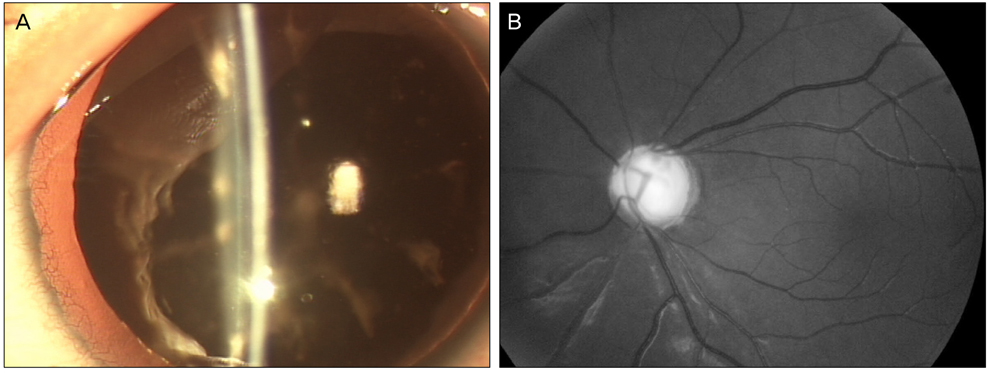Korean J Ophthalmol.
2010 Oct;24(5):291-296. 10.3341/kjo.2010.24.5.291.
Clinical Features of Korean Patients with Congenital Aniridia
- Affiliations
-
- 1Department of Ophthalmology and Visual Science, The Catholic University of Korea School of Medicine, Seoul, Korea. mskim@catholic.ac.kr
- KMID: 974323
- DOI: http://doi.org/10.3341/kjo.2010.24.5.291
Abstract
- PURPOSE
To investigate the clinical features of Korean patients with congenital aniridia.
METHODS
This retrospective study focused on 60 eyes from 31 patients who were diagnosed with congenital aniridia at Kangnam St. Mary's Hospital from 1996 to 2007. Patient age, gender, visual acuity (VA), family history, and previous ocular history were recorded. The presence of keratopathy, glaucoma, cataract, foveal hypoplasia, and other ocular or systemic anomalies were evaluated for each patient.
RESULTS
The proportion of sporadic cases was 29.0%. Cataract (82.5%), glaucoma (51.6%), keratopathy (71.6%), and foveal hypoplasia (81.8%) commonly accompanied aniridia. Thirty-four (60.7%) eyes had VAs less than 20/200 and 20 eyes (35.7%) had VAs between 20/200 and 20/60. In patients without a past history of ocular surgery, the mean central corneal thickness was 643.05 +/- 37.67 microm and the mean endothelial cell count was 3,349.44 +/- 408.17 cells/mm2. Ocular surface surgeries were performed in 6 eyes. The clarity of the transplanted corneal graft vanished in 5 eyes with the progression of peripheral neovascularization and subepithelial fibrosis. The mean age of cataract surgery in 8 eyes was 29.8 +/- 5.9 years. Postoperative worsening of corneal clouding and glaucomatous damage were observed in 4 eyes. Two infants had bilateral congenital glaucoma. Two children with sporadic aniridia were identified to have Wilm's tumors.
CONCLUSIONS
Congenital aniridia is a progressive congenital disorder that is commonly accompanied by complications that can lead to impaired vision. Regular, careful examinations for these accompanying complications should be performed in all patients with congenital aniridia.
MeSH Terms
Figure
Cited by 1 articles
-
Clinical Features and Molecular Characteristics of Korean Patients with Congenital Aniridia
In Kyun Hahn, Dae Hee Kim, Hyun Taek Lim
J Korean Ophthalmol Soc. 2016;57(9):1441-1450. doi: 10.3341/jkos.2016.57.9.1441.
Reference
-
1. Prosser J, van Heyninen V. PAX6 mutations reviewed. Hum Mutat. 1998. 11:93–108.2. Hill RE, Hanson IM. Molecular genetics of the Pax gene family. Curr Opin Cell Biol. 1992. 4:967–972.3. Macdonald R, Wilson SW. Pax proteins and eye development. Curr Opin Neurobiol. 1996. 6:49–56.4. Holland EJ, Djalilian AR, Schwartz GS. Management aniridic keratopathy with keratolimbal allograft: a limbal stem cell transplantation technique. Ophthalmology. 2003. 110:125–130.5. Tremblay F, Gupta SK, De Becker I, et al. Effects of PAX6 mutations on retinal function: an electroretinographic study. Am J Ophthalmol. 1998. 126:211–218.6. Nelson LB, Spaeth GL, Nowinski TS, et al. Aniridia. A review. Surv Ophthalmol. 1984. 28:621–642.7. Shaw MW, Falls HF, Neel JV. Congenital aniridia. Am J Hum Genet. 1960. 12(4 Pt 1):389–415.8. Park YG, Suh DH, Lee HS. 4 cases of congenital aniridia. J Korean Ophthalmol Soc. 1977. 18:419–422.9. Ahn SK, Kang JS, Shyn KH. A case of congenital aniridia. J Korean Ophthalmol Soc. 1989. 30:815–818.10. Park SJ, Kim HT, Kim SM, Chung SK. Implantation of blackdiaphragm intraocular lens in cataract surgery with congenital aniridia. J Korean Ophthalmol Soc. 1998. 39:1748–1754.11. Kim JH, Hwang BS, Lee JH, Cha SC. PAX6 mutations and clinical features of congenital aniridia. J Korean Ophthalmol Soc. 2008. 49:1794–1800.12. Eden U, Beijar C, Riise R, Tornqvist K. Aniridia among children and teenagers in Sweden and Norway. Acta Ophthalmol. 2008. 86:730–734.13. Lopez-Garcia JS, Garcia-Lozano I, Rivas L, Martinez-Garchitorena J. Congenital aniridia keratopathy treatment. Arch Soc Esp Oftalmol. 2006. 81:435–444.14. Weiss JS, Demartini D, Brown R, Forster RK. Specular microscopy in aniridia. Cornea. 1987. 6:27–31.15. Muir KW, Duncan L, Enyedi LB, et al. Central corneal thickness: congenital cataracts and aphakia. Am J Ophthalmol. 2007. 144:502–506.16. Lee H, Khan R, O'Keefe M. Aniridia: current pathology and management. Acta Ophthalmol. 2008. 86:708–715.17. Lopez-Garcia JS, Rivas L, Garcia-Lozano I, Murube J. Autologous serum eyedrops in the treatment of aniridic keratopathy. Ophthalmology. 2008. 115:262–267.18. Brauner SC, Walton DS, Chen TC. Aniridia. Int Ophthalmol Clin. 2008. 48:79–85.19. Tsai JH, Freeman JM, Chan CC, et al. A progressive anterior fibrosis syndrome in patients with postsurgical congenital aniridia. Am J Ophthalmol. 2005. 140:1075–1079.20. Reinhard T, Engelhardt S, Sundmacher R. Black diaphragm aniridia intraocular lens for congenital aniridia: long-term follow-up. J Cataract Refract Surg. 2000. 26:375–381.21. Grant WM, Walton DS. Progressive changes in the angle in congenital aniridia, with development of glaucoma. Am J Ophthalmol. 1974. 78:842–847.22. Swanner JC, Walton DS, Chen TC. Prevention of aniridic glaucoma with goniosurgery. Int Ophthalmol Clin. 2004. 44:67–71.


